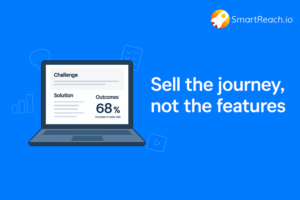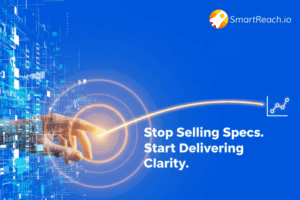A Comprehensive Guide To Cold Email
Cold emailing is a powerful way to reach new prospects, generate B2B leads, and grow your sales pipeline (when done correctly).
The key to successful cold emailing lies in crafting a concise, engaging message that captures attention, builds interest, and encourages a response, ultimately fostering new business opportunities and relationships.
This guide covers cold email strategies, examples, and tools to help you boost reply rates and land in the inbox.
What is a cold email?
A cold email is an unsolicited yet personalized email sent to someone you haven’t interacted with before. It is typically used for sales, partnerships, or recruiting. It aims to start a business conversation, not to spam.
Here’s one example of a typical cold email 👇🏻

Cold Emailing v/s Email Marketing: are they different?
Cold email and email marketing are different. Here’s how –
#1. Audience & Consent
- Cold Email targets people who haven’t interacted with you before usually B2B professionals found through prospecting tools. Consent is implied under strict compliance (e.g., GDPR, CAN-SPAM).
- Email Marketing is for users who’ve opted in—such as subscribers, leads, or customers—typically B2B or B2C.
#2. Intent & Goal
- Cold Email starts a new conversation with a potential lead.
- Email Marketing nurtures existing relationships and promotes products or updates.
#3. Tools & Platforms
- Cold Email Tools: SmartReach.io, Lemlist, Instantly
→ Focus on personalization, inbox rotation, and automation.
- Email Marketing Tools: Mailchimp, Drip, ActiveCampaign
→ Built for mass campaigns, templates, and subscriber list management.
#4. Email Format & Design
- Marketing emails are HTML-rich, visual, branded, and contain multiple CTAs.
- Cold Emails are plain-text, 1:1, short, and personal—designed to look like a real email from a human.
Here’s a quick summary of the points –
| Criteria | Cold Email | Email Marketing |
|---|---|---|
| Audience | Cold, non-subscribed B2B leads | Opted-in subscribers |
| Goal | Start conversations | Nurture leads or customers |
| Email Style | Text-based, personal | Visual, promotional |
| Best For | B2B lead generation | Newsletters, campaigns, product updates |
| Tools Used | SmartReach.io, Instantly, Lemlist | Mailchimp, ActiveCampaign, Drip |
What are the benefits of cold emailing?
Cold emails are proven as highly effective as an outbound marketing strategy when executed correctly.
Here are some key advantages of cold emailing:
| Benefit of cold emails | Why It Matters |
|---|---|
| Cost-Effective | Requires no ad budget or design—just a verified email and the right tool. |
| Highly Targeted | Reach decision-makers using firmographic and intent-based filters. |
| Personalized | Tailor each message using name, title, company, or pain point to get replies. |
| Scalable | Start small, then scale to thousands of emails/month using automation tools. |
| Measurable | Track opens, replies, bounces, and optimize based on real-time data. |
✅ TL;DR
- Cold emailing is low-cost, high-impact.
- It allows you to personalize outreach at scale.
- It’s scalable with automation and email warm-up features.
- You get full visibility into what’s working and what’s not.
Is it legal to send cold emails?
Yes, sending cold email is legal provided you’re compliant with data protection and email laws in different regions of the world.
Here are some key regulations to follow for cold emails –
United States:
- Comply with the CAN-SPAM Act
- Must include: a clear opt-out link, physical address, and no misleading subject lines.
European Union (GDPR):
- Must have a legitimate interest or clear consent.
- Emails must be relevant, minimal in data collection, and easily unsubscribable.
India & Other Regions:
- Laws vary but generally disallow bulk promotional mail without user consent.
For more information on different cold email related laws and regulations including how to send compliant emails, I have created a separate article.
Check out: Email Compliance Laws: Definitive Legal Guide for Marketers
What are some use cases of cold emailing?
Below are the most common cold email use cases, each with real-world relevance:
#1. Lead Generation
- Use Case: A SaaS company reaches out to startups offering a free trial of its productivity tool.
- Goal: Convert cold prospects into active users.
- Why it works: Personalized messaging and value-based offers improve response rates.
#2. Business Partnerships
- Use Case: A marketing agency contacts complementary service providers (e.g., dev shops) to propose bundled service offerings.
- Goal: Establish referral pipelines and co-marketing opportunities.
- Why it works: Targeted value alignment boosts interest in collaboration.
#3. Networking & Freelance Outreach
- Use Case: A freelance designer reaches out to local businesses offering design services with a portfolio and limited-time discount.
- Goal: Initiate conversations and win new clients.
- Why it works: Cold email humanizes outreach and opens doors without ads.
#4. Link Building for SEO
- Use Case: An SEO consultant contacts site owners offering guest posts or infographics in exchange for backlinks.
- Goal: Improve domain authority and SERP visibility.
- Why it works: Mutually beneficial outreach with relevant, high-value content.
#5. Recruitment & Talent Sourcing
- Use Case: A tech startup emails skilled candidates found on LinkedIn, highlighting culture, mission, and open roles.
- Goal: Attract qualified candidates to apply or schedule a call.
- Why it works: Direct, role-specific messaging increases response from passive candidates.
How to start an effective cold email outreach?
Below is a 6-step framework-expanded with real-life tactics—to help you get started with your cold emailing efforts.
Step 1 → Define your Ideal Customer Profile
Start by identifying exactly who your email is for.
This avoids wasted outreach and improves cold email personalization.

*example of a sample ICP structure
Define your ICP by these parameters:
- Industry (e.g., fintech, SaaS, logistics)
- Company size (e.g., 11–100 employees)
- Decision-maker roles (e.g., VP Sales, Head of Growth)
- Pain points (e.g., low reply rates, lead gen inefficiencies)
Pro Tip: Use firmographic filters and sales intent signals to laser-focus your email outreach list.
____________
Step 2 → Build a verified prospect list
An effective cold email campaign starts with clean, accurate contact data.
You need to build detailed information on your target prospects including their contact details like email addresses, LinkedIn IDs, company website and more such details.
How to source leads:
- Use tools like SmartReach.io’s B2B Lead Finder, Apollo.io, or LinkedIn Sales Navigator
- Extract: full name, business email, job title, company name, industry and other details
- Validate emails to reduce bounce rate (use email verification tools)
Pro Tip: Organize your list with tags like “ICP-fit,” “Referral source,” or “High-value prospect” to personalize messaging better.
___________
Step 3 → Set up email infrastructure
Setting up email infrastructure for cold emailing is crucial as it directly impacts the deliverability and the overall impact of your cold email campaigns.
1. Choose secondary domains + mailboxes for cold emailing
Never send cold emails from your main domain as it can blacklist your main domain that your website might be hosted on.
Create secondary domains (e.g., get.yourcompany.com) to isolate cold outreach and protect your primary domain’s reputation.
Best practices:
- Choose a domain that feels familiar and brand-aligned
- Register with a trusted domain registrar
- Pick email service providers that support authentication (e.g., SPF, DKIM)
Alternatively, you can buy pre-configured secondary domains and mailboxes that are already set-up and are ready to send.
They will save you time and hassle of all the technical set-ups.
2. Warm up your email inboxes
Over 20% of emails fail to reach inboxes due to insufficient warmup of new accounts.
Email warmup builds trust with inbox providers. Without it, your emails are likely to bounce or be flagged as spam.
There are 2 ways to warm-up emails –
- Manual: Start slow and send 5-7 emails/day per email inbox and increase gradually
- Automated: Use tools like Warmup Hero to simulate human interactions and automate warmup over 2–3 weeks.
The automatic method works best if you are dealing with more than 3 email inboxes and bunch of email domains. It runs automatically saving you time and hassle.
___________
Step 4 → Write high-converting email sequence
A cold email is not a pitch, it’s a conversation starter. Email personalization and tone matter more than polish.
A good email sequence must-haves:
- Subject line: Keep it short, curiosity-driven, and relevant (under 50 characters)
- Intro: Show relevance quickly (mention their role, recent activity, or company change)
- Value proposition: What problem do you solve? Why should they care?
- CTA: Ask a simple, low-friction question (e.g., “Is this worth a quick chat?”)
- Follow-ups: Send 3–5 polite reminders spaced over 7–10 days
Pro Tip: Use SmartReach.io’s content AI to automate personalization at scale. Using the latest LLM models, it generates personalized email sequences including subject lines, body copy etc.
What to avoid whil writing cold emails:
- Avoid using spammy words or making unsubstantiated claims.
- Do not sound robotic or overly formal; maintain a conversational tone.
- Avoid asking for too much too soon; focus on building rapport and demonstrating value gradually.
We have discussed in details on how to write cold emails better in our free cold email masterclass. Make sure to check that out!
____________
Step 5→ Track & measure email performance
Great cold email results don’t happen by accident they’re measured, iterated, and improved continuously.
Here’s how to track what matters and refine your approach based on actionable data.
Key metrics to monitor for cold emails
1. Deliverability Rate
Ensure your emails land in the inbox and not spam.
- Goal: Delivery rate > 95%
- Bounce rate: Keep below 5%
- Unsubscribe rate: Stay under 3% to avoid ESP flags
- Tip: Clean your list regularly and use SPF, DKIM, DMARC properly
2. Open Rate
Measure how many recipients open your emails—an indicator of email subject line effectiveness and sender trust.
- Good benchmark: 40–60%
- Pro tip: A/B test subject lines and optimize preview text (first 30–50 characters of your email)
3. Reply Rate
This is your real engagement metric.
- Benchmark: 8–20%
- Improve it by: Personalizing the body, clearly stating value, and ending with a soft, easy-to-answer CTA
4. Click-Through Rate (CTR)
CTR shows how often recipients click on your call-to-action (e.g., booking links, case studies).
- Typical range: ~2–5%
- Optimize by: Using one clear CTA and placing it contextually after your value message
____________
Step 6 → Continuous campaign optimization
Once you’ve measured performance, use those insights to fine-tune your future campaigns.
1. Test timing of the emails
There’s no universal “best time.” Test based on your audience’s role and time zone.
- Tip: Sales teams often reply in early mornings; HR contacts may engage after lunch
- Tools: Use SmartReach.io’s best time to send report to analyze and launch email campaigns for the best engagement.
Free Resource: Cheat Sheet : Best time to send cold emails
2. Adjust email length
Short, clear emails (50–125 words) generally perform best—but test formats.
- Try: 2-line intros, bullet-point benefits, 1 CTA
- Avoid: Overloading with features or jargon
3. Reframe your value proposition
Low reply rates with high open rates?
Your message may lack relevance or urgency. Fix this by:
- Rewriting intros to tie into recent news, triggers, or roles
- Showing results (e.g., “helped [X] cut response time by 43%”)
- Tightly aligning your offer with the ICP’s pain points
Cold email: takeaway
Smart, relevant, and personalized cold emails still work in 2025 especially when backed by data and deliverability infrastructure.
SmartReach.io gives you everything:
- Build email lists
- Personalize at scale
- Hit primary inboxes (not spam)
- Track opens, replies, and placements
Try SmartReach.io for free (you don’t need a credit card needed)
F.A.Qs on cold email outreach
Q: What’s the ideal cold email length?
A: Aim for 50–125 words—enough to introduce, add value, and ask one question without overwhelming.
Q: How many follow-ups should I send?
A: Send 2–4 polite follow-ups over 7–14 days, adding value each time—don’t overdo it.
Q: Should cold emails include links?
A: Avoid links and images in initial outreach—they reduce deliverability. Use plain text only.
Q: When is the best time to send cold emails?
A: Send mid-week (Tue–Thu) between 9–11 AM in recipients’ time zones for optimal open rates.
Q: How do I improve reply rates?
A: Personalize by name, mention a trigger or pain point, and end with a simple, relevant ask.




